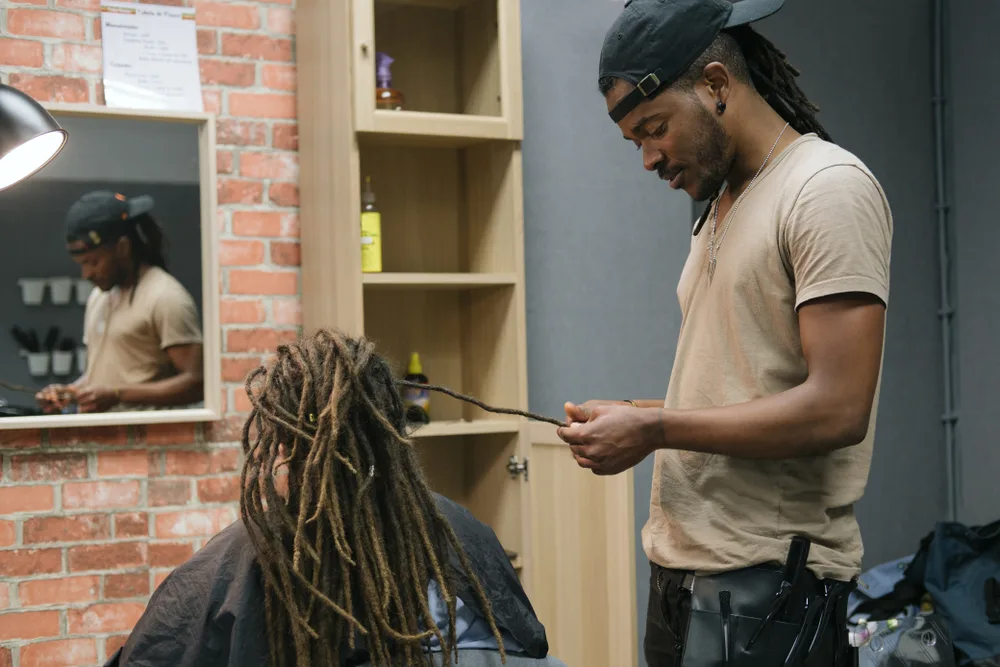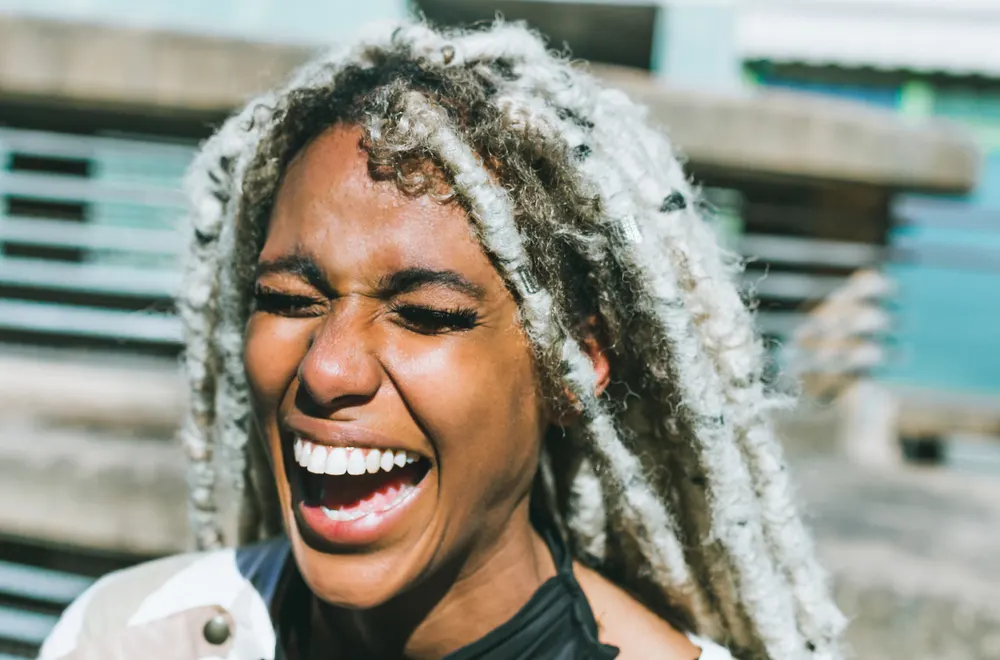Jump to:
Whether you’re just starting to learn more about different hairstyles, you’re a long-time follower of hair fashion, or you don’t want to insult someone by asking, you may be wondering, “are dreads dirty?”
Dreadlocks are a staple of natural Black hair, and there are artistic depictions of the style dating as far back as 2,500 BCE.
But, despite their long and storied presence in world culture, misconceptions about dreadlocks are still prominent. One of which is that they’re dirty, unwashed, and unmaintained. Let’s get into the nitty-gritty of the dreadlocks conversation.
Are Dreadlocks Dirty?
Dreadlocks aren’t objectively dirty. Like any other hairstyle, their cleanliness is dependent upon the level of maintenance they’re getting. Just like any other hairstyle, dreads can (and should) be washed.
But, like dyed hair, hair extensions, and chemically-treated hair, dreadlocks require specialized care to maintain their shine, texture, hydration level, and natural oils.
If you’re not actively maintaining your dreads with regular washing, and if you haven’t been to a stylist recently, they’re probably dirty. If you follow a maintenance routine that includes washing and salon visits, your dreads are clean.
You Might Also Like:
- Two-Strand Twist Dreadlock Style Guide
- How Long Does It Take to Grow Dreadlocks?
- How to Freeform Dreadlocks
Dreadlocks Can (and Should) Be Cleaned
@prospectthebarber Dread makeover #dreads #retwist #deepclean #femalebarber #texasbraiders #dirtydreads #fypage #dreads #dreadmaintanence #challenge #fyp #look #braids ♬ Back to the Streets (feat. Jhené Aiko) – Saweetie
Regular washing is crucial to dreadlock maintenance. Videos of stylists deep-cleaning dreadlocks have even become a TikTok trend. Historically, dreadlocks formed in textured (highly curly or kinky) hair as a result of prolonged periods without washing.
However, today’s dreadlocks are generally “faux dreadlocks,” meaning that they’ve been purposefully twisted by a hair stylist or via DIY methods.
Importantly, faux dreadlocks (used interchangeably with “dreadlocks”) require care and maintenance, including:
- First-time twisting by a stylist or at home
- Hair and scalp washing
- Hair and scalp moisturizing
- Periodic retwisting and salon maintenance
Read Next: How to Detox Dreadlocks
Salon Professionals Help Maintain Dreadlocks

AnnaTamila/Shutterstock
Sometimes called “Loctitians,” hair stylists who have experience creating, maintaining, and removing dreadlocks are vital in the salon and hairstyling industry.
Just like chemically straightened, permed, or dyed hair, dreadlocks require professional (or high-quality DIY) maintenance and products to keep their signature look.
But discrimination in the salon industry and lack of mandatory textured hair education in hairstyling training make Locticians (and Black hair specialists in general) difficult to find in many areas throughout the US.
Luckily, advocates for natural hair and the Black community are making progress, and the conversation about textured hair is changing:
- Legislation is pending that will provide discrimination protection for Black people with natural hair.
- Salons are becoming less segregated as stylists are interacting with more textured hair education.
- Celebrity and influencer-led conversations are making waves to decrease the stigmas surrounding natural Black hair
People with Dreadlocks Use Specific Products
Dyed hair should be washed with color-safe shampoo. Dreadlocks also require special care and tools designed specifically for dreads. Both DIYers and salon professionals use a variety of products to maintain dreadlocks, including:
- Various varieties of vinegar can be used as a pre-shampoo wash
- Baking soda solutions, another pre-shampoo wash method
- Clarifying shampoos that don’t leave residue
- Oil, avocado, or other natural oils that can improve hydration
- Specialized brushes, clippers, and edge tools for styling
Naturally, salon professionals have the most access to high-quality specialty products, so if you’re interested in getting dreads for the first time, we recommend talking to a stylist who can help you create a maintenance schedule — especially if you’re used to relaxing or braiding your hair.
Read Next: The 7 Best Shampoos for Dreads in 2024
What to Do If Your Dreadlocks Are Dirty
If your dreadlocks are dirty, it’s time to wash them — it’s just that simple. But, if you don’t have time for a wash day routine today, but you need a refresher, consider:
- Lightly spraying your hair with water to provide temporary hydration
- Wrapping your dreads in a hot, wet towel to slightly loosen the twists and temporarily hydrate
- Wearing a headscarf or hat until wash day (if the situation is dire)
If you notice that someone else’s dreads look dirty, it’s probably best to keep your comments to yourself. If you’re not a salon professional, the condition of someone else’s hair is none of your business.
Frequently Asked Questions

DisobeyArt/Shutterstock
“Are dreadlocks dirty?” is a frequent inquiry from people with limited exposure to Black hairstyles. But, it’s not the only taboo question about textured hair that you might be too afraid to ask in person.
Do Dreadlocks Smell?
Do dreadlocks smell? Perhaps, if they haven’t been maintained. If you don’t have dreadlocks, and you’ve been skipping a regularly-scheduled hair wash routine, your hair might develop an odor, too.
Hair that’s collected excess dirt, oils, or dead skin can develop an odor. The same is true of dreadlocks; if they’re maintained, they probably smell like the products someone is using to wash them.
Are Dreadlocks Good for Your Hair?
Dreadlocks aren’t inherently bad for your hair, but they simply might not be ideal for your hair texture. Hair texture is classified with two metrics:
- Strand shape (straight, wavy, curly, or coily)
- Curl size (large, medium, or small)
Someone with curly hair and a large curl size, for instance, might have too much space between each strand to effectively twist locks of hair into dreadlocks.
But someone with coily hair and a small curl size might have an easier time getting their hair strands to hold in place during the twisting process, making dreadlocks easier to create.
How Do People Get Dreadlocks?
Let’s return to the “dreadlocks” vs. “faux dreadlocks” conversation. Dreadlocks are naturally-occurring, and they’re generally the result of insufficient hair washing. However, even naturally-occurring dreadlocks usually require some maintenance.
At minimum, twisting individual locks of hair to form a twist. Faux dreadlocks are created at home or by a salon professional similarly — twisting individual, clean locks of hair into a coil.
When they style their hair in dreads for the first time, many people use holding products to train their hair to stay twisted until their next salon visit. With time, however, dreadlocks will hold their shape without using products.
How Long Do Dreadlocks Last?
With regular, healthy maintenance (including washing and hydration), dreadlocks can last indefinitely- like any other hairstyle. Most styles require some level of maintenance:
- Chemically straightened or permed hair needs to be periodically retreated to retain its shape.
- Dyed hair needs to be recolored to maintain vibrancy and color new hair as it grows from the root.
- Braided hair needs to be re-styled when the braids loosen or begin to fall out.
- Dreadlocks need to be re-twisted periodically to maintain their shape.
As long as the wearer takes good care of their hair and performs regular maintenance, their dreadlocks could last a lifetime.
Why Do People Think Dreadlocks Are Dirty?
There are certainly dreadlock-wearers who don’t have the time, resources, or knowledge to maintain the hairstyle. However, the racism built into the salon and hair styling education system is partially to blame for the lack of access to high-quality information about textured hair.
But, as education improves, correct information is spread on social media, and more people learn that dreads aren’t inherently dirty, society will see two changes:
- People will have better access to the information they need to maintain their hair
- Public perception of dreadlocks will gradually improve as factual information becomes easier to find
But, right now, the answer to this question is simple—people think dreadlocks are dirty because they know too little about them.
So, Are Dreadlocks Dirty?
Are dreadlocks dirty? No, as long as they are maintained. Dreadlocks, like perms, chemically straightened hair, or dyed hair, are a hairstyle. And, like other hairstyles, they’re as clean as the wearer keeps them.
While public perception about dreadlocks is slowly changing, we should continue to educate ourselves about hairstyles, behaviors, and choices we don’t understand before rushing to judgment.
Improved access to Black hair education in the salon industry and the spread of facts about textured hair will improve the public opinion of dreadlocks and allow people access to information and care for their hair. And you can bet that we’re doing our best to do just that.
